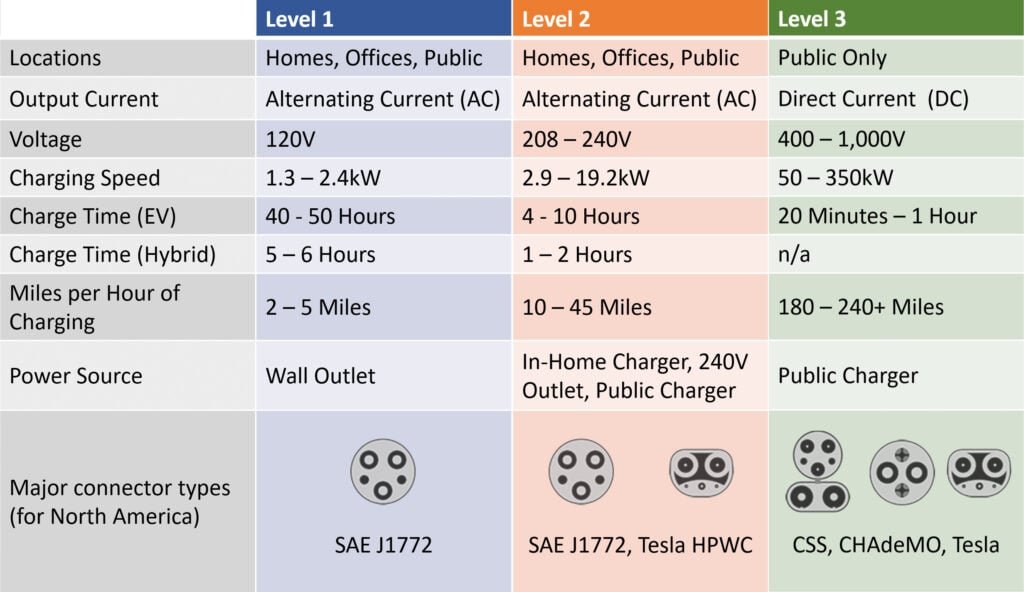
Voltage and Power: Level 1 charging uses a standard 120-volt wall outlet, the same one you use to charge your smartphone. It’s the simplest method, requiring no special installation. Because it uses regular household electricity over many hours, many new EV owners ask, is it expensive to charge an electric car at home? The low cost per charge is often a pleasant surprise.”
Şarj Hızı: This level adds approximately 2 to 5 miles of driving range per hour of charging.
Usage: Ideal for overnight charging at home, especially for plug-in hybrid electric vehicles (PHEVs) or for EV owners with low daily mileage.
Key Advantages:
✅ No need for professional installation (compatible with standard household outlets)
✅ Equipment cost close to zero (standard in car purchase)
✅ Low power characteristics to protect the long-term health of the battery
Voltage and Power: Level 2 chargers utilize a 240-volt outlet, Level 2 charger ranges from 6.2 to 19.2 kW, with most chargers around 7.6 kW.
Şarj Hızı: They can add 32 miles of driving range per hour of charging.
Usage: Found in homes, workplaces, and public locations like shopping malls and hotels, Level 2 chargers are the workhorse of the EV charging world. They require a 240-volt power supply and professional installation. For property owners considering this essential upgrade, the overall charging station cost, which includes hardware and installation, is a key factor in their planning.
Technological Breakthroughs:
🔌 Intelligent charging management (supports time-of-use tariff optimization)
🔌 OCPP protocol compatibility (for commercial operation scenarios)
🔌 Dynamic load balancing (simultaneous charging of multiple devices)
Voltage and Power: DC Fast Chargers operate at 480 volts, delivering between 60 kW and 400 kW of power.
Şarj Hızı: They can add 173 to 298 miles of driving range in just one hour of charging.
Usage: Primarily located in public charging stations along highways and in urban areas, DC Fast Chargers are designed for quick top-ups during long trips.
Often called Level 3, DC Fast Chargers are the titans of the industry. This advanced hardware is a significant investment, leading business owners to ask how much does a commercial ev charging station cost? The answer varies based on power output, which can range from 50kW to over 350kW.
These stations are typically found along major highways and in dedicated charging hubs. Since these are public-facing, drivers need a way to pay for their sessions. Understanding how to pay for EV charging via app, card, or credit card is essential for a smooth road trip experience.
The creation of these charging hubs has become a major business opportunity, with some entrepreneurs building their own networks or even exploring an electric vehicle charging franchise model to enter this fast-growing market.
Selecting the appropriate charging level depends on several factors:
| Charger Type | Equipment Cost(USD) | Installation(USD) | Total Range(USD) |
|---|---|---|---|
| Level 1 | N/A | 0-500 | 0-500 |
| Level 2 | 400-1,200 | 800-2,000 | 1,200-3,200 |
| DC Fast | 30k-150k | 20k-100k | 50k-250k |
Europe
| Charger Type | Equipment (EUR) | Installation (EUR) | Total Range (EUR) |
|---|---|---|---|
| Level 1 | N/A | N/A | N/A |
| Level 2 | 600-1,500 | 1,000-3,000 | 1,600-4,500 |
| DC Fast | 40k-180k | 30k-120k | 70k-300k |
| Region | Level 1 | Level 2 | DC Fast |
|---|---|---|---|
| NA | <$50 | $100-300 | $3k-8k |
| EU | N/A | €80-250 | €2.5k-7k |
Key Components:
Level 1/2: Socket replacement, circuit inspection
DC Fast: Cooling system maintenance, connector replacement (8-12% annual rate), software updates
Regional Variations
Grid Standards: EU residential 230V single-phase vs. NA 120V system
Certifications: UL in NA vs. CE+EN 61851 in EU
Grid Upgrade: NA requires 100-480kW connections, 80% new EU installations include energy storage systems
1. Charging power selection
Level 1 (Portable):
North America 120V/15A (1.4-1.9kW), Europe 230V/10A (2.3kW)
Daily range supplement: about 50-80km (suitable for short-distance commuting)
Cost: 600 for the device, no professional installation required
Level 2 (wall-mounted):
North America 240V/40A (7.7-11.5kW), Europe 400V 3-phase (11-22kW)
3-6 times faster charging, 4-8 hours to full capacity
Installation cost: North America 2,000, Europe €1,000-€3,500 (including circuit modification)
2. Intelligent Function Configuration
Basic version: LED status indication + overvoltage protection
Advanced version (recommended)
WiFi/4G remote control (OTA upgrade support)
Time-sharing tariff charging scheduling (save 30% electricity cost)
Vehicle identification authentication (RFID/APP unlocking)
3. Vehicle model compatibility verification
American Standard Vehicles: Confirm SAE J1772 interface compatibility
European standard vehicles: check IEC 62196 Type2 interface version
Tesla: Factory adapter (250) required
IP65 / IK10
Üç Gövde Tasarımı
Güç yapılandırılabilir 80A'ya (19,2kW) kadar
5” (7”optional) LCD Screen
Tak ve Şarj Et ISO 15118 (donanıma hazır)
Size detaylı teknik bilgi ve fiyat teklifi göndereceğiz!